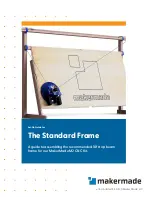
GENERAL & SPECIFIC
SAFETY INSTRUCTIONS
1. KNOW YOUR TOOL
Read and understand the owners manual and labels affixed to the
tool. Learn its application and limitations as well as its specific
potential hazards.
2. KEEP GUARDS IN PLACE.
Keep in good working order, properly adjusted and aligned.
3. REMOVE ADJUSTING KEYS AND WRENCHES.
Form habit of checking to see that keys and adjusting wrenches are
removed from tool before turning it on.
4. KEEP WORK AREA CLEAN.
Cluttered areas and benches invite accidents. Make sure the floor
is clean and not slippery due to wax and sawdust build-up.
5. AVOID DANGEROUS ENVIRONMENT.
Don’t use power tools in damp or wet locations or expose them to
rain. Keep work area well lit and provide adequate surrounding work
space.
6. KEEP CHILDREN AWAY.
All visitors should be kept a safe distance from work area.
7. MAKE WORKSHOP CHILD-PROOF.
Make workshop child-proof with padlocks, master switches or by
removing starter keys.
8. USE PROPER SPEED.
A tool will do a better and safer job when operated at the proper
speed.
9. USE RIGHT TOOL.
Don’t force the tool or the attachment to do a job for which it was not
designed.
10. WEAR PROPER APPAREL.
Do not wear loose clothing, gloves, neckties or jewelry (rings,
watch) because they could get caught in moving parts. Non-slip
footwear is recommended. Wear protective hair covering to
contain long hair. Roll up long sleeves above the elbows.
11. ALWAYS WEAR SAFETY GLASSES.
Always wear safety glasses (ANSI Z87.1). Everyday eyeglasses
only have impact resistant lenses, they are
NOT
safety glasses.
Also use a face or dust mask if operation is dusty.
12. DON’T OVERREACH.
Keep proper footing and balance at all times.
13. MAINTAIN TOOL WITH CARE.
Keep tools sharp and clean for best and safest performance.
Follow instructions for lubricating and changing accessories.
14. DISCONNECT TOOLS.
Before servicing, when changing accessories or attachments.
15. AVOID ACCIDENTAL STARTING.
Make sure the switch is in the ‘’OFF’’ position before plugging in.
16. USE RECOMMENDED ACCESSORIES.
Consult the manual for recommended accessories. Follow the
instructions that accompany the accessories. The use of improper
accessories may cause hazards.
17. NEVER STAND ON TOOL.
Serious injury could occur if the tool tips over. Do not store
materials such that it is necessary to stand on the tool to reach them.
18. CHECK DAMAGED PARTS.
Before further use of a tool, the guard or other parts should be
carefully checked to ensure that they will operate properly and
perform their intended function. Check for alignment of moving
parts, breakage of parts, mounting, and any other conditions that
may affect its operation. A guard or other parts that are damaged
should be properly repaired or replaced.
19. NEVER LEAVE MACHINE RUNNING UNATTENDED.
Turn power ‘’OFF’’. Don’t leave any tool running until it comes to a
complete stop.
SPECIFIC SAFETY INSTRUCTIONS FOR YOUR BUFFER
1.
INSTALL THE BUFFER
on a stand or workbench to prevent buffer
from moving or tipping during use. See Assembly Instructions.
2.
WEAR TIGHT GLOVES
when buffing, the workpieces can get hot or
have sharp edges. Gloves should be tight so they will not get caught
in the buffing wheel. Leather gloves are recommended.
3.
NEVER BUFF SMALL WORKPIECES
without them being properly
held by pliers or clamps, or they will be ripped out of your hands and
possibly cause harm to you or damage the item.
4.
DO NOT STAND IN FRONT OF THE BUFFER
. Stand to one side of
the Buffer and turn it “ON”. Wait at the side for one minute until the
machine comes up to full speed. There is always a possibility that
debris from a glazed or damaged buffing wheel may be discharged
towards the operator.
5.
ALLOW THE BUFFER TO REACH FULL SPEED BEFORE
BEGINNING WORK
. Hold the work piece securely, and slowly ease
the work into the buffing wheel. Be careful of any sharp edges or
corners that may catch on the wheel and be torn from your hands.
6.
DO NOT
buff using the sides or the rear of the buffing wheels. Buff
only on the wheel slightly below the wheel center.
7.
NEVER STOP THE BUFFER BY FORCING MATERIAL INTO THE
WHEEL
. Let the buffer stop rotating on its own.
8.
RESURFACE/DRESS THE BUFFING WHEEL OFTEN.
This will
keep the wheel surface free of residue and glaze. Use a metal rake
or stiff wire brush.
9.
THE DIAMETER OF THE BUFFING WHEELS WILL DECREASE
WITH USE
. Replace the buffing wheels when they become too
small for effective buffing, or when the sewn or bonded material
break apart.
10.
REPLACE A DAMAGED BUFFING WHEEL IMMEDIATELY
. A
damaged wheel can discharge debris at a high velocity towards the
operator. Tighten the spindle nuts just enough to hold the buffing
wheels firmly on the arbors. DO NOT overtighten the spindle nuts.
Only use the wheel flanges provided with the buffer. When selecting
a replacement buffing wheel, use only properly sized wheels, and
verify that the wheel has a higher RPM rating than the maximum
RPM of the Buffer.

























